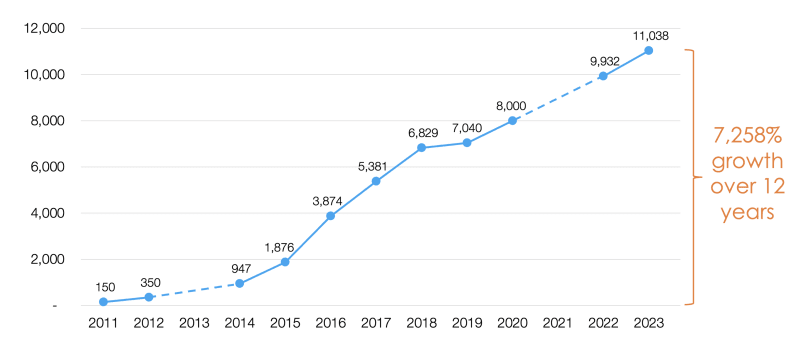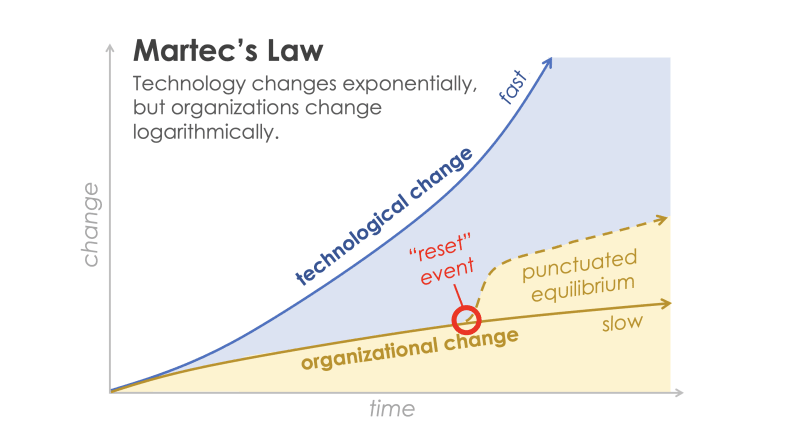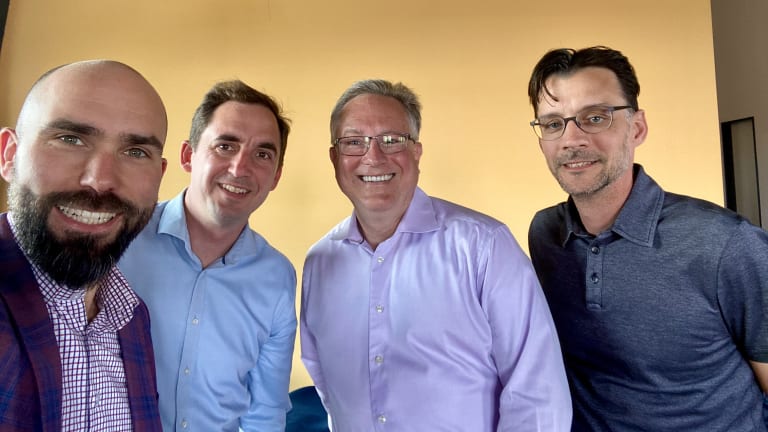In a recent presentation titled "Martech Supercollider," Scott Brinker, editor at chiefmartec.com and author of the renowned Marketing Technology Landscape Infographic, delved into the convergence of AI, cloud data warehouses, and composability/no-code in the marketing technology space.
Scott's presentation focused on the concept of a "Martech Supercollider," a term he coined to describe the powerful convergence of AI, cloud data warehouses, and composability/no-code. This convergence, he argued, is reshaping the marketing technology landscape, offering unprecedented opportunities for businesses to leverage technology in their marketing efforts.
Since Kentico was the sponsor of this event organized by Boye & Co, I had a chance to ask Scott some follow-up questions.
The interview: a deep dive into martech maturity and composability.
Question: How do you perceive the maturity of companies in terms of embracing the influx of tools and the speed of innovation in the market?
Scott: There's a very wide distribution in how mature companies are with leveraging marketing technology. We often hear stories about those who are fairly successful and those who are doing cutting-edge things. But most companies are not there. The fast rate of technological change and the relatively slow curve of organizational change becomes the driver and, in many ways, the constraint of what you can do from a marketing technology perspective. One of the ways I think about it is the 90/10 rule introduced by Avinash Kaushik. It says that martech is about 10% investing in technology and 90% investing in people. And I think that is so right on. Very often in martech, people over-index on the technology dimension and under-index on the investment they need to make in their people.
Question: What can companies do to increase the speed of embracing these changes?
Scott: The obvious one is the actual training to teach people how to use these tools and technologies. But the truth is that we really learn by doing. And so there's only so much we learn by sitting in a class or doing exercises that are in a very sandbox environment. To really develop these skills, people need to be encouraged to apply them. You need to ensure that the culture encourages people to experiment with applying these tools. Now, that doesn't mean that should be the Wild West. There shouldn't be governance and help. But it makes a big difference. Suppose it's like people standing over your shoulder wagging your finger, saying you're doing it wrong versus people who are constructive, like “this is good… here, watch out for this”, or how when you run into a roadblock, you have someone who can help you, to really encourage you.
Question: How do you see the concept of composability evolving in the martech space?
Scott: Composability is one of those terms that can get interpreted in a lot of different ways. On one end of the spectrum, you've got software development, which has been composable for quite some time. But then there's another level of composability that's way on the other end of the spectrum, which is almost a configurability. It's this idea to say like: Okay, I have a particular workflow, or I want to do a particular experience, like on a webpage for a customer. Can I just call this thing here? And I wanted to have this design there. And I want to pull data from there. And then from a composability perspective, the things people are composing, they're actually relatively lightweight. They're not these superadvanced, sophisticated applications, but they're very useful for what those individuals are trying to get done. It's about being able to pull together different components in a way that makes sense for your specific needs. This level of composability is where most people need it and where significant progress is being made.

Growth of martech tools covered by Martech Technology Landscape infographic.
Key takeaways from Scott Brinker’s presentation.
Scott's insights underscore the importance of a people-centric approach to leveraging marketing technology. While technological advancements offer exciting opportunities, the real challenge lies in training people, encouraging experimentation, and streamlining processes to make the most of these tools. As Scott referenced Avinash Kaushik's 90/10 rule, it's crucial to understand that the success of martech is 10% technology and 90% investment in people.
The concept of composability, as discussed by Scott, also presents a promising avenue for companies to create tailored solutions that meet their specific needs. By focusing on creating lightweight but useful tools and workflows, companies can better leverage the power of martech, regardless of their digital maturity level.
In the rapidly evolving world of martech, understanding and navigating these trends will be crucial for businesses looking to stay ahead of the curve. As Scott's presentation and interview highlight, the future of martech lies in the intersection of people, processes, and technology.

Scott Brinker's Martec's Law explaining the differences between technological and organizational change.
Translating martech to employees.
People were the cornerstone of Angelika Gust’s presentation too. Angelika is Head of Marketing at S-Bahn Berlin, and her talk was called “The hidden success factor behind martech.”
Angelika also emphasized the importance of people in the martech equation. She identified two groups as the hidden champions of martech: martech specialists and employees with direct or indirect customer touchpoints. To maximize the potential of martech, companies should focus on transforming these employees into enthusiastic martech users. She also argued that it shouldn’t be called Marketing Technology but Communication Technology to emphasize the importance of all people communicating on behalf of the company.
Angelika also highlighted the importance of addressing fears like job loss due to AI advancements. She underscores the need for roles like Data Translator and Martech Operationalizer, who can bridge the gap between martech specialists and other employees.
To achieve this, Angelika suggests a comprehensive strategy:
- Demystify martech: make sure everyone understands what martech is and how it can benefit them and the company.
- Identify needs: understand the needs of different employee groups. Addressing their specific concerns and showing them how martech can solve their problems will win their support.
- Train and educate: provide training on martech tools and explain their metrics and KPIs. This will empower employees to use these tools effectively.
- Create a consistent understanding: ensure everyone in the organization has a consistent understanding of KPIs. This will facilitate collaboration and alignment.
- Stay updated: keep abreast of martech developments. This will allow the company to adapt and leverage new opportunities.
In essence, Angelika's presentation underscores that the future of martech lies in the intersection of technology, people, and strategic alignment. By focusing on these areas, companies can unlock the full potential of martech.
The reality of digital experience maturity growth.
Our Kentico partners and customers were also part of the events. Jan Havel, co-founder of ACTUM Digital, presented a case study of APOK in Hamburg, and together with Delfin Vassallo, Marketing Director at Uponor, they presented a case study of Uponor in Copenhagen. Also Roel Kuik, Kentico Practice Lead at Aviva Solutions, and Michael van Dijk from APS IT-diensten presented their case study of replatforming from Sitecore to Kentico.
From these presentations, it's clear that a crucial aspect of successful technology implementation is aligning it with business needs. By understanding the unique requirements and goals of the business, companies can choose and tailor their technology solutions for maximum effectiveness. This alignment not only improves operational efficiency but also enhances user experience and satisfaction, leading to better engagement metrics.
Moreover, these insights emphasized the importance of adaptability and the willingness to pivot to other goals and approaches when necessary. Whether it's creating a user-friendly interface for content editors, implementing a unified component library, or addressing industry-specific challenges in B2B ecommerce, the ability to adapt and pivot is key.
In essence, these learnings underscore the principle of "listen to understand". By actively listening to the needs of the business, the users, and the industry, companies can make informed decisions about their technology implementations. This approach, coupled with a focus on employee satisfaction and a readiness to embrace change, can lead to significant improvements in both business performance and user experience.
Want to learn more about digital experience maturity? Check out our ebook.

